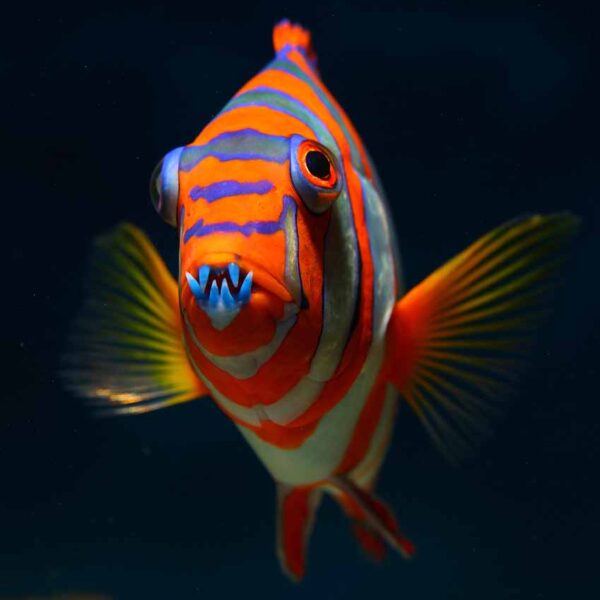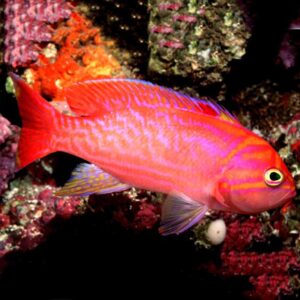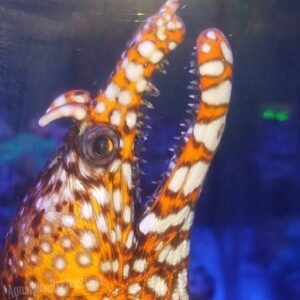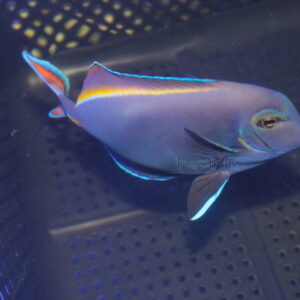Description
The Harlequin Tusk Australian Adult, Choerodon fasciatus, native to Australia, is a fish known for its striking appearance. It can reach a maximum size of about 12 inches (30 centimetres). They have a fantastic, vibrant orange body, decorated with white and blue bands. Their head is prominent, with a large mouth and sharp teeth.
Taxonomy
Belonging to the genus Choerodon and the family Labridae, the Harlequin Tusk exhibits several identifying features. Its closest relatives within the genus include the Bluehead Tusk Choerodon cyanodus. The name “Choerodon” is derived from Greek, meaning “pig tooth,” which refers to the fish’s robust teeth.
Natural Habitat
In its natural habitat, the Harlequin Tusk can be found in coral reef environments. These habitats are characterized by vibrant and diverse marine life, including various coral formations, sea fans, and sponges. The fish seeks shelter among the crevices and gaps within the coral, which provide protection from predators.
Keeping Harlequin Tusk Australian Adult Healthy:
The Harlequin Tusk has a moderate care level, requiring an experienced aquarist to ensure its well-being. Maintaining water quality is crucial, with temperatures ranging between 75°F and 82°F (24°C and 28°C) and a pH level of 8.1 to 8.4. Regular water changes and the use of a protein skimmer are recommended to provide optimal conditions.
Special Requirements and Feeding
Harlequin Tusk fish have specific dietary needs. They are carnivorous and require a varied diet consisting of meaty foods such as frozen shrimp, fish, and squid. It is beneficial to feed them small meals multiple times a day rather than a single large feeding. Providing live or frozen foods can help mimic their natural feeding habits.
How Many Should I Keep?
It is advisable to keep only one Harlequin Tusk per aquarium due to their territorial nature. They may become aggressive towards conspecifics and other similarly shaped species.
Lighting Preference
Harlequin Tusk fish do not have specific lighting requirements. However, providing moderate to high-intensity lighting with a combination of white, blue, and purple spectrum bulbs can enhance the overall aesthetic appeal of the aquarium and complement their vibrant coloration.
Suitable Tank Mates
When selecting tank mates for the Harlequin Tusk, it is crucial to consider compatible species that can withstand its territorial behaviour. Peaceful and larger fish species, such as tangs, butterflyfish, and larger wrasses, can be suitable companions. Avoid housing them with small, docile species that may become targets for aggression.
Reproduction in the Wild
The Harlequin Tusk fish (Choerodon fasciatus) reproduces through a process of spawning in the wild. The exact details of their reproductive behaviour in the wild are not fully documented. They are egg layers and are known to form distinct pairs.
Breeding Choerodon fasciatus:
Breeding the Harlequin Tusk, scientifically known as Choerodon fasciatus, can be challenging but rewarding. Here is a general overview of the breeding process:
- Set up:
Prepare a separate breeding tank with optimal conditions. Maintain a temperature range of 24°C to 28°C (75°F to 82°F) and a pH level of 8.1 to 8.4. Provide suitable hiding places and live rock for the fish to establish territories.
- Courtship/Spawning:
Introduce a healthy male and female into the breeding tank. They will engage in natural courtship behaviours, which may include displays of colours and movements. The female releases her eggs, and the male fertilizes them externally. It is essential to provide ample hiding spots for the female to deposit her eggs.
- Rearing:
After spawning, it is crucial to remove the adult fish to prevent them from consuming the eggs. The eggs will hatch within 24 to 48 hours, and the fry will rely on their yolk sacs for initial nourishment. Once the yolk sac is absorbed, you can start feeding them with appropriate-sized live or frozen foods. Maintain excellent water quality and perform regular water changes to support the fry’s growth.
Sexual Dimorphism
Sexual dimorphism in the Harlequin Tusk fish is not easily distinguishable based on physical characteristics alone.
Distribution
The Harlequin Tusk Australian Adult, Choerodon fasciatus is naturally found in the waters of the Indo-Pacific region, particularly in Australia. While captive-bred and line-bred strains may be available, the original wild fish of this species can be found in Australia.
Summary
Breeding the Harlequin Tusk fish can be a challenging but rewarding endeavour. By setting up the appropriate breeding tank, observing natural courtship behaviours, and providing optimal rearing conditions, you can increase the chances of successful breeding.
The Fish pictured here are representative only and the livestock you receive may vary in pattern, coloration, and shape.









Reviews
There are no reviews yet.